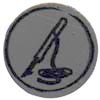 |
|
|
|
PDF-Rules: Nanuuk! (630kb)
|
A tactical game for the whole family Playing time: 30 minutes Summary: Game Contents Game preparations (Nanuuk!) Variants (Game of introduction) Design: Günter Cornett - Graphics: Christof Tisch |
Game Contents- 1 game board: showing the mighty ice-floe.  - 21 light-colored animal pieces
- 16 dark-colored equipment pieces
- 4 dark-colored "Inuk" pieces - 4 hunter pieces (in the colors red , blue , yellow and white)  - 3 wooden polar-bears  - about 70 wooden sticks to mark cracks in the ice 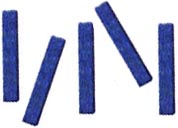 - 4 game sheets in the player colors
red , blue , yellow
 with the necessary information about kills, equipment and the score
- these rules Part of this game is also a booklet about the life of the Inuit . (Inuit, singular Inuk, is the name used by the people living in the Arctic in their own language.)
|
Introductory GameInformation: - Game Preparations -The wooden sticks are placed beside the game board. Each player receives one hunter piece. In a two-player game both players get two hunter pieces. In a three-player game only a part of the game board is needed.: All spaces marked with three points are not used in the game. It may be helpful to cover them with animal or equipment pieces turned upside down. - Start of the game -Players take turns places their hunter pieces on a open space of the game board. In a two-player game the first player places one of his hunters on a open space. Then the other player places both of his hunters on open spaces. Finally the first player places his second hunter piece. - How to move -The first player moves his hunter (in a two-player game: one of his hunters) towards an open adjoining space. When the new space is entered a crack appears in the ice. Cracks always divide two spaces. A crack always starts in one corner of the space just entered and ends at a point which is not a corner of that space. The cracks extend in a star-shape in any direction away from the just entered space. Two basic rules for every move are A hunter piece never can be moved across a crack! There may only be one hunter in each space! Each crack is marked with a wooden stick. Logically then, a crack can only arise where no other crack already exists, this means where no wooden stick lies. Naturally no crack can appear on the edges of the ice floe. If all spaces adjoining the space just entered are already divided by cracks then a new crack forms between the corners of the just entered space. Example:The hunter moves from space A to space B.  The cracks: As long as at least one line named c in the drawing is not covered by a wooden stick, the player must lay down a wooden stick on one of the open c-lines (Fig. 1). If all c-lines are occupied he places the crack on an open d-line (Fig. 2). 
The player moving the hunter piece can decide within the bounds of the rules where the crack arises. After the move the next player takes a turn. (back to The hunting)
- End of the game -A hunter piece standing on a space which on all sides is blocked by either cracks, other pieces or the edge of the ice floe cannot move. In a three- or four-player game this piece is removed from the game board. The other players play until only one player is left. He is the winner. In a two-player game a players loses if, at the beginning of his move, both of his hunter pieces cannot move or if one of his pieces cannot move only due to cracks or cracks and the edge of the ice floe. At the end of these rules you can find some variants for the Introductory Game. |
- Start of the game -Players take turns setting their hunter piece on the igloo space of their choice. The igloo spaces are the only spaces in the game where more than one hunter piece can stand at the same time. All igloos belong to all hunters together. In the four-player-game at least two hunters must start from the same igloo. The player who places his hunter piece as the second one in an igloo should look carefully so that he chooses an igloo which gives a good starting position to both hunters. In the two-player game it makes sense that both hunter pieces start from different igloos. - The Hunting -The player whose turn it is moves his hunter piece to an adjoining space. The basic movement rules from the Introductory Game are valid: only move to spaces where there are no other hunters, never cross a crack (exception: see rules for kayaks), mark a new crack with a wooden stick. If a hunter cannot move because his way is blocked, he stays on his space (he lays down no new wooden stick). It depends on what is lying on the space a hunter enters which action he can perform next: Inuk If no Inuk already accompanies the hunter (this means the Inuk-place on the left-hand side of the game sheet is still free), this Inuk will follow him. (The Inuk piece is placed on the Inuk place on the left-hand side of the game sheet.) Fish, seal, walrus 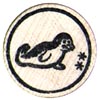  If the hunter has his harpoon and there is a open place on the left-hand side of the game sheet for that animal, the player may take the animal piece
from the board and place it in his personal bag (on the left-hand side of the game sheet). Whale
This is the same as hunting
fish, seal or walrus, except that the hunter must be accompanied by an Inuk,
who helps him hunting the whale (i.e. the Inuk place on the left-hand side of the game sheet must be covered by an Inuk piece). General rule: A hunter piece can be moved to a space even if the player cannot or does not wish to take the animal piece on it. 
Polar bearThe hunter chases away the polar bear with a throw of his harpoon. This means that the player moves the polar bear to any open space on the game board he likes (not containing any hunter piece, nor animal piece, nor an igloo space).In the process the hunter looses his harpoon: The player places the harpoon piece from the left to the right side of the game sheet. The hunter may no longer hunt until he has moved to any igloo. Without a harpoon a hunter may also not move to a space containing a polar bear, as he would be unable to banish it. Entering the igloo the hunter gets a new harpoon: The player moves the harpoon piece from the right-hand side of the game sheet to the left. During the first round it is impossible to move to a space with a polar bear on it because the polar bear could not be moved to another open space. - In the Igloo: Exchange Animals for Equipment -Whenever a player enters any igloo space with his hunter piece, he can exchange the animals in his personal bag for equipment in the igloo (see also game sheet):- a fish for a husky The exchanged animal pieces are moved from the left-hand side to the corresponding places on the right of the game sheet, while the exchanged equipment pieces are moved from right to left of the game sheet. An exchange is naturally only possible if the hunter does not already have the equipment corresponding to the hunted animal. If he already has it, he nevertheless may lay down one or more animal pieces in the igloo. An Inuk who helped hunting a whale stays in the igloo only if the whale is placed in the igloo. This means that the Inuk piece moves only to the right-hand side of the game sheet only if the whale piece also does. In all other cases the Inuk follows the hunter. Logically a hunter can kill only one whale with the same Inuk. Using the kayak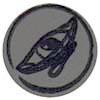 (back to hunting) Using husky and sledge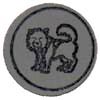  Husky and sledge can only be used together. They allow the hunter to move twice: Tip: The actions "using the kayak" and "using husky and sledge" can be combined. Theoretically a triple move is possible: If the first step of a double move ends in an igloo and the player gets husky and sledge there again, they can be used to double the second movment of the first double move. This is also valid for the kayak. - End of the game -The game ends if there are no more animals which can be hunted and all hunter pieces are either returned to an igloo or unable to return to any igloo. The players tally their points for their hunted animals:
each fish counts 1 point * It is irrelevant if an animal is on the left-hand side or on the right-hand side of the game sheet. Each player whose hunter piece is in an igloo when the game ends gets 2 extra points (**). The player with the most overall points wins. If players have equal points the one with more equipment (on the left-hand side of the game sheet) wins. |
|
Introductory Game VariantsPartnership Variant (for four players)The players sitting opposite one another are trying to trap the other without being trapped themselves. The rules are the same as in the basic game with each pawn being able to start in any vacant space. The first time that a player is unable to move his pawn, his cross-board opponent wins. All other players lose. In terms of tactics, both cross-board players will usually try to move toward each other so to be able to trap the other. At the same time, they will hope to isolate the other two players and give them as much space as possible so that neither becomes too quickly enclosed. Neighbourhood variantAs a further variant, instead of trying to trap the player opposite, you can try trapping the player to the left, or as another variant, to the right. Helpers variant (a two-player game)Each player gets a polar bear and an Inuk piece. The goal is to enclose the opponent's polar bear. If an Inuk piece is enclosed the game is harder to win for the player in question but not lost at all. The Inuk only helps the polar bear. (You can tell one polar bear from the other if one player uses two polar bears together as if very fat.) Two Inuit hunt a polar bear (a three-player game)The game is played on 24 spaces. Two players each get an Inuk piece while the third one gets a polar bear. The polar bear may move once or twice in each round. A crack only arises at the end of the move. The polar bear wins if one Inuit is enclosed. The Inuit win both together if the polar bear is enclosed. Variants:a) When the polar bear moves twice a crack arises after each step. b) The polar bear must always move twice. c) The polar bear may move once or twice or stay on its space. If it stays on a space a crack arises at the space where it is. d) If the Inuit encloses the polar bear, they fight for the fur, this means they try to enclose each other. Two Inuit hunt a polar bear (a two-player game)As in the three-player game. One player gets both Inuit. Two Inuit fear a polar bear (a two-player game)Each player gets an Inuk piece. A polar bear (or maybe two or three) placed on the game board first is moved each round by every player (and creates a crack with every move). Variants: a), b), c) as above
Variants of Nanuuk!1. If using husky and sledge the player may choose if he wants to create one or two cracks (either one crack at the end of the double-move or one crack after each step of the double-move). 2. If you want to avoid that one player has no more moves during the game, the following rule can be agreed upon: a wooden stick must not be placed blocking a hunter's way to every igloo, if it is possible. This means the following order has priority in the example at page 4: a) lay down wooden stick on an
open c-line,
without blocking any player This rule is somewhat more complicated, not as thrilling, but also more social. 3. If you want a game with fewer chances to move, one could place some wooden sticks on the game board during the game preparations. |
|
Special thanks to......the many test players: Getraude, Monika, Gabi, Rupert, Jana, Stefan, Christof, Martina, Wolfgang, and all others I have forgotten here. ... Alf and all other people from KSKl and to Gertraude und Benni for the toilsome stamping of the animal and equipment pieces at the Essen fair "Spiel '98". ...last but not least special thanks to Gertraude, the author of the game Twilight Wolfgang, Michaela, and Benni for never resting explanition of the games at our stall. and for translation: Lutz Pietschker, who translated the booklet Inuit - Hunters of the Arctic. At his german/english website http://flyhi.de/ you'll find many good information about gaming and parachute jumping. Michael Siedentopf, a game designer, who translated this rules. You can see his game ideas at his website: http://www.geocities.com/TimesSquare/1360/ (in german).
The designerGünter Cornett: born in 1960 in Flensburg I live, play and work in Berlin; I construct web-sites and review games; I like to play Tichu, Settlers of Catan-basic game, 1830... The graphic designerChristof Tisch Christof Tisch out of Achern/Baden , living in Wiesbaden, playing for a long time, not for such a long time drawing (among other things the sign from the german journal "Pöppel-Revue") and designing communication as profession. Like to play Ursuppe, Acquire, Tyranno Ex, Tichu, Kreml...
|
 |
 |
   
Bambus Spieleverlag Günter Cornett | Kopfstraße 43 | D-12053 Berlin Phone/Fax: +49-30-6121884 |
| just archiv data +++ no orders +++ German infos Archiv-Seite +++ nicht aktuell +++ keine Bestellungen! Infos hierzu sowie aktuelles Impressum: www. bambusspieleverlag. de |


